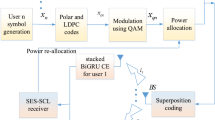Abstract
In recent years, massive multiple input multiple output (MIMO) systems have received a particular focus on the contemporary research. This study investigates the pilot contamination problem in a massive MIMO uplink system. This problem has always been evident in the surrounding cells experiencing reuse of the piloting sequence on the massive MIMO system that leads to the deterioration of the decoding system. Unlike most of previous solutions to this problem, which assume the availability of perfect channel state information (CSI) or based on estimating the CSI using the pilot sequence, this article develops a novel blind decoding algorithm for MIMO uplink systems, that significantly mitigates the pilot contamination problem. The proposed method based on higher order cumulants utilizes independent statistical methods prior to the encoding without using pilot sequences. The proposed method estimates the channel matrix and separates the received signals from in-cell and neighbouring cells through a reduction in the cumulants dependent cost-effective functioning. Simulation results indicates that the presented blind decoding algorithm enhances the performance of the decoding process and outperforms the zero-forcing (ZF) and the minimum-mean square-error (MMSE) schemes under imperfect CSI. Moreover, the presented method approaches the MMSE deciphering performance and ZF interpreting with perfect CSI at high SNR.





Similar content being viewed by others
References
Rusek, F., Persson, D., Lau, B. K., Larsson, E. G., Marzetta, T. L., Edfors, O., et al. (2013). Scaling up MIMO: Opportunities and challenges with very large arrays. IEEE Signal Processing Magazine, 30(1), 40–60.
Cichocki, A., & Amari, S. (2002). Adaptive blind signal and image processing: Learning algorithms and applications. New York: Wiley.
Marzetta, T. L. (2010). Noncooperative cellular wireless with unlimited numbers of base station antennas. Transactions on Wireless Communications, 9(11), 3590–3600.
Yin, H., Gesbert, D., Filippou, M., & Liu, Y. (2013). Coordinated approach to channel estimation in large-scale multiple-antenna systems. IEEE Journal on Selected Areas in Communications, 31(2), 264–273.
Zhang, J., Zhang, B., Chen, S., Mu, X., El-Hajjar, M., & Hanzo, L. (2014). Pilot contamination elimination for large-scale multiple-antenna aided OFDM systems. IEEE Journal of Selected Topics in Signal Processing, 8(5), 759–772.
Ngo, H. Q., Larsson, E. G., & Marzetta, T. L. (2013). The multicell multiuser MIMO uplink with very large antenna arrays and a nite-dimensional channel. IEEE Transactions on Communications, 61(6), 2350–2361.
Muller, R. R., Cottatellucci, L., & Vehkapera, M. (2014). Blind pilot decontamination. IEEE Journal of Selected Topics in Signal Processing, 8(5), 773–786.
Biguesh, M., & Gershman, A. B. (2006). Training-based MIMO channel estimation: A study of estimator tradeoffs and optimal training signals. IEEE Transactions on Signal Processing, 54(3), 884–893.
Jose, J., Ashikhmin, A., Marzetta, T., & Vishwanath, S. (2011). Pilot contamination and precoding in multi-cell TDD systems. IEEE Transactions on Wireless Communications, 10(8), 2640–2651.
Gopalakrishnan, B., & Jindal, N. (2011). An analysis of pilot contamination on multi-user MIMO cellular systems with many antennas. In Proceedings of IEEE international workshop on signal process advanced wireless communication (SPAWC) (pp. 381–385), San Francisco, CA, USA.
Yin, H., Gesbert, D., Filippou, M., & Liu, Y. (2013). A coordinated approach to channel estimation in large-scale multiple-antenna systems. IEEE Journal on Selected Areas in Communications, 31(2), 264–273.
Wang, H., Pan, P., Shen, L., & Zhao, Z. J. (2014). On the pair-wise error probability of a multi-cell MIMO uplink system with pilot contamination. IEEE Transactions on Wireless Communications, 13(10), 5797–5811.
Bogale, T. E., & Le, L. B. (2014). Pilot optimation and channel estimation for multiuser massive MIMO systems. In Proceedings of 48th annual conference on information systems (pp. 1–6).
Albataineh, Z., & Salem, F. (2015). Robust blind multiuser detection algorithm using fourth-order cumulant matrices. Circuits, Systems, and Signal Processing, 34, 2577–2595.
Albataineh, Z., & Salem, F. (2013). New blind multiuser detection DS-CDMA algorithm using simplified fourth order cumulant matrices. In IEEE international symposium on circuit and system (ISCAS) (pp. 1946–1949).
Wang, H., Chen, R. M., & Shen, L. (2012). Performance analysis of ZF and MMSE receivers in uplink of MU-MIMO system. In Proceedings of IEEE 1st international conference commununications in China (pp. 114–119).
Luo, M., Li, L., Qian, G., & Liao, H. (2014). Circuits, Systems, and Signal Processing. Multidimensional blind separation using higher-order statistics: Application to non-cooperative STBC systems. 33, 2173–2192.
Eldemerdash, Y. A., Dobre, O. A., & Oner, M. (2016). Signal identification for multiple-antenna wireless systems: Achievements and challenges. IEEE Communications Surveys & Tutorials, 18(3), 1524–1551.
Ma, J., & Li, P. (2014). Data-aided channel estimation in large antenna systems. IEEE Transactions on Signal Processing, 62(12), 31110–3124.
Shen, L., Yao, Y.-D., Wang, H., & Wang, H. (2016). Blind decoding based on independent component analysis for a massive MIMO uplink system in microcell Rician/Rayleigh fading channels. IEEE Transactions on Vehicular Technology, 65(10), 8322–8330.
Liu, X., Cardoso, J.-F., & Randall, R. B. (2010). Very fast blind source separation by signal to noise ratio based stopping threshold for the SHIBBS/SJAD algorithm. Mechanical Systems and Signal Processing, 24(7), 2096–2103.
Cardoso, F. (1994). On the performance of orthogonal source separation algorithms. In Proceedings of EUSIPCO (pp. 776–779).
Liu, X. & Randall, R. B. (2005). A new efficient independent component algorithm: Joint approximate diagonalization of simplified cumulant matrices. In The 16th national congress of Australian Institute of Physics, Canberra, Australia
Rutishauser, H. (1966). The Jacobi method for real symmetric matrices. Numerical Mathematics, 9, 1–10.
Albataineh, Z., & Salem, F. (2014). Blind multiuser detection DS-CDMA algorithm on the fast-relative newton algorithm. In Wireless telecommunication symposium (WTS) (pp. 1–5). IEEE.
Albataineh, Z., & Salem, F. M. (2016). Adaptive blind CDMA receivers based on ICA filtered structures. Circuits, Systems, and Signal Processing.,. https://doi.org/10.1007/s00034-016-0459-4.
Comon, P., & Jutten, C. (Eds.). (2010). Handbook of blind source separation independent component analysis and applications. Oxford: Academic Press.
Author information
Authors and Affiliations
Corresponding author
Additional information
Publisher's Note
Springer Nature remains neutral with regard to jurisdictional claims in published maps and institutional affiliations.
Rights and permissions
About this article
Cite this article
Albataineh, Z. Blind Decoding of Massive MIMO Uplink Systems Based on the Higher Order Cumulants. Wireless Pers Commun 103, 1835–1847 (2018). https://doi.org/10.1007/s11277-018-5883-2
Published:
Issue Date:
DOI: https://doi.org/10.1007/s11277-018-5883-2




